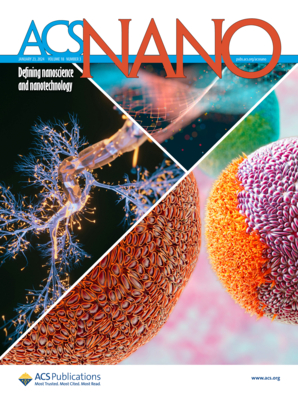Focused Acoustic Vortex-Activated Dual-Stimuli Nanoplatform Synergizes with Checkpoint Blockade to Enhance Macrophage Phagocytosis and Antitumor Immunity.
IF 15.8
1区 材料科学
Q1 CHEMISTRY, MULTIDISCIPLINARY
引用次数: 0
Abstract
Macrophage activation in tumor immunotherapy is hindered by the "do not eat me" evasion mechanism, mediated by the CD47-SIRPα axis. Current therapeutic strategies that solely block antiphagocytic signals show limited efficacy in solid tumors, indicating the urgent need to simultaneously enhance "eat me" signals. To this end, we developed a focused acoustic vortex (FAV)-triggered dual-stimuli-responsive nanoplatform to enhance macrophage phagocytosis. This nanoplatform consists of a liposome coloaded with Cas9/sgRNA complexes and the sonosensitizer chlorin e6 (Ce6), enabling a FAV-triggered activation cascade. Upon FAV exposure, this system facilitates (1) enhanced cellular uptake by increasing membrane permeability through cavitation; (2) activation of Ce6 to generate reactive oxygen species, inducing calreticulin exposure to enhance "eat-me" signals; and (3) disruption of endosomes/lysosomes to release the Cas9/sgRNA complexes for CD47-specific knockout. This strategy enhanced macrophage phagocytosis of tumor cells, promoted M2-to-M1 macrophage polarization, and activated T-cell-mediated immune responses, resulting in significant antitumor efficacy in the 4T1-tumor-bearing mouse model. Programmed death-ligand 1 (PD-L1) checkpoint blockade following nanoplatform activation amplified systemic immune responses, resulting in 90% inhibition of primary and 80% inhibition of distant 4T1 tumors, and long-term immune memory. This study presents a strategy for precision immunotherapy through spatiotemporally controlled modulation of phagocytic signaling pathways.聚焦声涡激活双刺激纳米平台与检查点阻断协同增强巨噬细胞吞噬和抗肿瘤免疫。
巨噬细胞在肿瘤免疫治疗中的激活受到CD47-SIRPα轴介导的“不吃我”逃避机制的阻碍。目前仅阻断抗吞噬信号的治疗策略对实体肿瘤的疗效有限,这表明迫切需要同时增强“吃我”信号。为此,我们开发了一个聚焦声涡(FAV)触发的双刺激响应纳米平台来增强巨噬细胞的吞噬作用。该纳米平台由载Cas9/sgRNA复合物的脂质体和声敏剂氯e6 (Ce6)组成,可实现faf触发的级联激活。在FAV暴露后,该系统促进(1)通过空化增加膜通透性来增强细胞摄取;(2)激活Ce6生成活性氧,诱导钙网蛋白暴露,增强“吃我”信号;(3)破坏核内体/溶酶体,释放Cas9/sgRNA复合物,用于cd47特异性敲除。该策略增强了巨噬细胞对肿瘤细胞的吞噬,促进了m2到m1巨噬细胞的极化,激活了t细胞介导的免疫应答,在4t1荷瘤小鼠模型中产生了显著的抗肿瘤效果。在纳米平台激活后,程序性死亡配体1 (PD-L1)检查点阻断放大了全身免疫反应,导致原发性4T1肿瘤抑制90%,远端4T1肿瘤抑制80%,以及长期免疫记忆。本研究提出了一种通过时空控制吞噬信号通路的精确免疫治疗策略。
本文章由计算机程序翻译,如有差异,请以英文原文为准。
求助全文
约1分钟内获得全文
求助全文
来源期刊

ACS Nano
工程技术-材料科学:综合
CiteScore
26.00
自引率
4.10%
发文量
1627
审稿时长
1.7 months
期刊介绍:
ACS Nano, published monthly, serves as an international forum for comprehensive articles on nanoscience and nanotechnology research at the intersections of chemistry, biology, materials science, physics, and engineering. The journal fosters communication among scientists in these communities, facilitating collaboration, new research opportunities, and advancements through discoveries. ACS Nano covers synthesis, assembly, characterization, theory, and simulation of nanostructures, nanobiotechnology, nanofabrication, methods and tools for nanoscience and nanotechnology, and self- and directed-assembly. Alongside original research articles, it offers thorough reviews, perspectives on cutting-edge research, and discussions envisioning the future of nanoscience and nanotechnology.
 求助内容:
求助内容: 应助结果提醒方式:
应助结果提醒方式:


